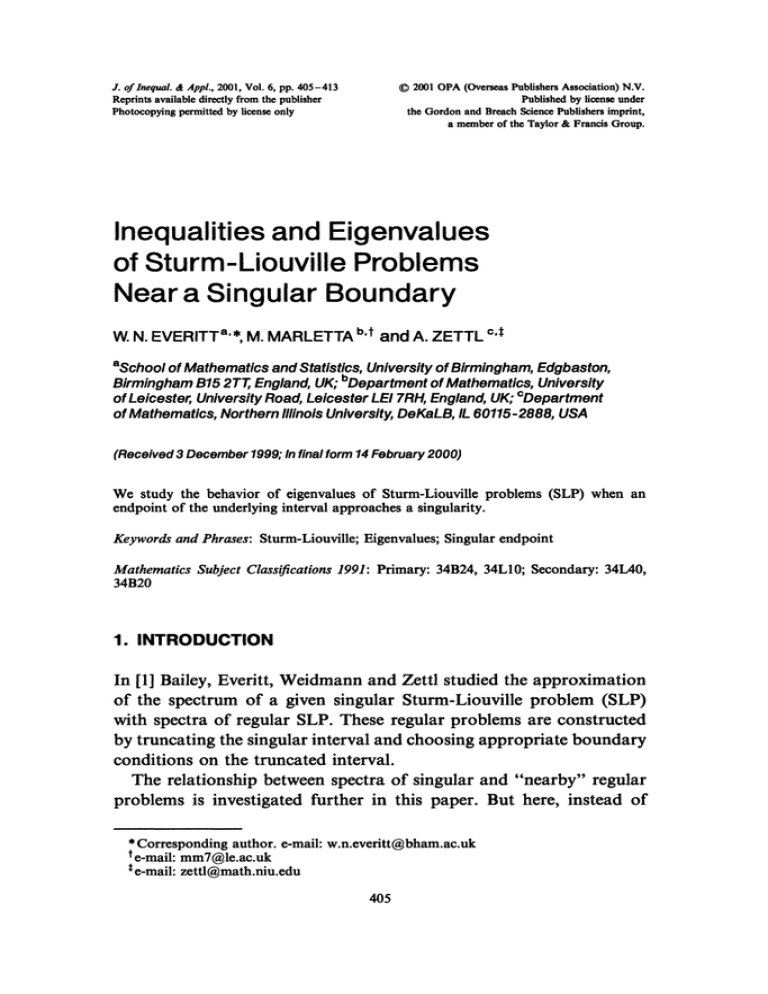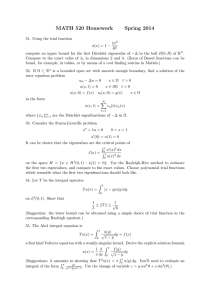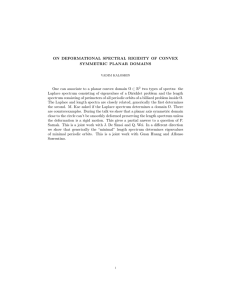Document 10944023
advertisement

(C) 2001 OPA (Overseas Publishers Association) N.V.
Published by license under
the Gordon and Breach Science Publishers imprint,
a member of the Taylor & Francis Group.
J. oflnequal. & Appl., 2001, Vol. 6, pp. 405-413
Reprints available directly from the publisher
Photocopying permitted by license only
Inequalities and Eigenvalues
of Sturm-Liouville Problems
Near a Singular Boundary
W. N. EVERITT a’*, M. MARLETTA b,t and A. ZETTL ’t
aSchool of Mathematics and Statistics, University of Birmingham, Edgbaston,
Birmingham B15 2TT, England, UK; bDepartment of Mathematics, University
of Leicester, University Road, Leicester LEI 7RH, England, UK; CDepartment
of Mathematics, Northern Illinois University, DeKaLB, IL 60115-2888, USA
(Received 3 December 1999; In final form 14 February 2000)
We study the behavior of eigenvalues of Sturm-Liouville problems (SLP) when an
endpoint of the underlying interval approaches a singularity.
Keywords and Phrases: Sturm-Liouville; Eigenvalues; Singular endpoint
Mathematics Subject
34B20
Classifications 1991" Primary: 34B24, 34L10; Secondary: 34LA0,
1. INTRODUCTION
In [1] Bailey, Everitt, Weidmann and Zettl studied the approximation
of the spectrum of a given singular Sturm-Liouville problem (SLP)
with spectra of regular SLP. These regular problems are constructed
by truncating the singular interval and choosing appropriate boundary
conditions on the truncated interval.
The relationship between spectra of singular and "nearby" regular
problems is investigated further in this paper. But here, instead of
*Corresponding author, e-mail:
e-mail: mmT@le.ac.uk
e-mail: zettl@math.niu.edu
w.n.everitt@bham.ac.uk
405
406
W.N. EVERITT et al.
"going from outside in" we take the "inside out" approach. Given a
regular SLP with an endpoint which is close to a singular endpoint,
what happens to the eigenvalues as the regular endpoint is moved
closer to the singular one? We shall see that the answer depends very
strongly on the nature of the spectrum of the singular problem. The
singular spectrum is a "strong attractor": it attracts the eigenvalues
of the regular problems from the truncated intervals toward itself.
This illustrates dramatically the point made by Zettl in I11], and in
particular in [12], that in order to understand the behavior of eigenvalues of regular problems one needs to have a perspective which includes the singular case.
Some related results are given in [2, 3, 6, 7, 4, 5].
For the general theory of linear differential operators see [9,
Chapter V].
In Section 2 we introduce some notation and summarize the basic
results used subsequently. Section 3 contains our main result for the
case when the spectrum is not bounded below. Section 4 deals with the
case when the spectrum of the singular problem is discrete, and in
Section 5 we study the case when the essential spectrum is not bounded
below and is non-empty.
2. NOTATION AND BASIC RESULTS
In this paper we use the notation and terminology from [1], however
for the convenience of the reader, we introduce some of the basic
notation here. Consider the equation
-(py’)’ + qy Awy on J (a, b) with
o < a < b < oo;
(2.1)
where the coefficients satisfy
p-l, q, w E Lloe(J, ) and p > O, w > 0 almost everywhere on J. (2.2)
Let {ar r E 1} be a decreasing sequence converging to the endpoint a,
and {br" r 1} an increasing sequence converging to endpoint b; here
d { 1, 2, 3,... }, the spectral parameter A C and a < ar < br < b; also
let Jr (ar, br) for all r
STURM-LIOUVILLE PROBLEMS
407
Under the conditions (2.2) the Eq. (2.1) may be singular at one or
both endpoints, but note that it is regular at each of the truncated
endpoints a, b for r
Let S be a self-adjoint realization of (2.1) on (a, b), and Sr a selfadjoint realization of (2.1) on (at, b) for r E Il. Then S= S* is a selfadjoint operator in the Hilbert function space Lz(J, w) and Sr S’; is a
self-adjoint operator in the Hilbert space Lz(J, w) for r E 1. Let tr(S),
tr(S) denote the spectra of S, S, respectively. It is well known, see the
recent paper [8], that the spectra of both S, and Sr are not bounded
above and that the spectrum of S is bounded below and discrete. Let
N0 {0, 1, 2,... } and let
tr(Sr)
{An(St): n 0}
{An(Jr: ar, Br): n 0}.
Here A,, B, are the matrices which determine the self-adjoint realization S, on (at, b,), for details see [12].
In general, the spectrum of S in the singular case may be quite
complicated: there may be no eigenvalues, finitely many, infinitely
many, a mixture of eigenvalues and essential spectrum, there may be
eigenvalues embedded in the essential spectrum, etc. Let
tr0
inf try(S),
where tre(S) denotes the essential spectrum of .S. We distinguish three
cases for tre(S):
tr0=--oo,
--oo<tr0<o,
tr0=o.
In the first case the essential spectrum is not bounded below, in the
second case it is bounded below and not empty, in the third case it
is empty, i.e., the spectrum of S is discrete but may or may not be
bounded below.
Our results in this paper depend on three Lemmas which we now
state.
,
let n denote
LEPTA 2.1 (Kong, Wu and Zettl). For any fixed r
the n-th Dirichlet eigenvalue and let )n denote the n-th eigenvalues of any
other self-adjoint realization on the interval (a, b), n o. Then
o
,’nD _</n+2 _< ’n+2
for allnENo
Proof See [5, Section 4, Theorem 4.1].
W.N. EVERITT et al.
408
LEMMA 2.2 (Bailey, Everitt, Weidmann and Zettl). Let S be a selfadjoint realization on (a, b) and its induced restriction on (at, br). Then
the sequence (:r} is spectral included for S, i.e., given any
A t(S) there exists n(r, )0
for each r [ such that
S
o
Proof See [1].
LEPTA 2.3 (Bailey, Everitt, Weidmann and Zettl). Let the hypotheses
and notation
1.
of Lemma 2.2 hold.
If a(S) is bounded below, then the sequence {S
exact for S below ao(S), this means that if
r
)
is spectral
and A < tro(S), then A e tr(S).
If each endpoint of (a, b) is, independently, either R or LC, then
{g:r e Il} is spectral exact for S, regardless of whether the spectrum of S is bounded below or not.
3. If a(S) is bounded below and discrete, then
2.
{An(Sir)}
"-}
An, as r ---, oo, for each n E [o.
Proof See [1].
1
3. THE SPECTRUM IS UNBOUNDED BELOW
Our first main result deals with the case when the singular spectrum is
not bounded below and shows the effect this has on the eigenvalues of
any self-adjoint extension of the "nearby" regular problems.
THEOREM 3.1 Assume that a(S) is not bounded below. Suppose S
is any self-adjoint realization on the interval (ar, br) with spectrum
a(Sr)= {An(Sr) n E Ilo}. (Sr is, in general, determined by different
boundary conditions for different r.) Then
{An(St)}
"-’}
-oo as r ---} o0,
for each n [o.
STURM-LIOUVILLE PROBLEMS
409
Proof Denote the eigenvalues of the induced restriction S by A
An(S) for all n E 0. By Lemma 2.1 it is sufficient to show that each
sequence of Dirichlet eigenvalues tends to -oo. It is well known that
each Dirichlet eigenvalue is a decreasing function of the increasing
length of the interval. (This follows from the variational characterization of the Dirichlet eigenvalues; for a different proof see [7]. This
latter proof of Kong and Zettl makes it clear why each eigenvalue is a
decreasing function of the increasing length of the interval in the case
of Dirichlet boundary conditions and, in general, for no other set of
separated self-adjoint boundary conditions.) Hence for each n E I10
the limit
-
{ADn (ar, br)}
In as r oo
exists. We claim: In -oo. Suppose In > -oo. Choose #k E a(S) such
that
#n+3
< # < PO < In.
< #n+2 < #n+ <
By spectral inclusion of Lemma 2.2, for each #k there exists an index
sequence n(r, #k) such that
{ A(,,,) }
-
#k.
From this and Lemma 2.1 it follows that n(r,/Zk) >_ k. Again from
o
o
Lemma 2.1 we get that A(_,,+)_
2 < A, which is a contradiction since
n(r,#n+)-2 >_ n. Thus {AnY(a,, b)} -oo as r--, oo for each nE0,
and the conclusion follows since Ann(at, b,) > An for the n-th eigenvalue
m
An of any other self-adjoint boundary condition,
4. DISCRETE SPECTRUM
The next result is part of Lemma 2.3; we state it here to highlight it and
because it contrasts with Theorem 3.1 of Section 3. We remark further
on this contrast below.
THEOREM 4.1 Assume that a(S) is bounded below and discrete with
spectrum a(S)= {An(S)" n E Io}. Suppose is the induced restriction
of S on the interval (ar, br) as defined in [1] with spectrum
r
W.N. EVERITT et al.
10
o’(S) {An(S,)
n
Io}. Then
{ An (St)} --* An (S) as r
Proof
-
oo for each n
o.
This is part (3) of Lemma 2.3.
Remark 4.1 Note the contrast between Theorem 3.1 and Theorem
4.1. This illustrates dramatically the enormous influence that the
spectrum of a singular problem has on the eigenvalues of nearby
regular problems. This point becomes even more interesting when
viewed in terms of the asymptotic behavior of the eigenvalues: For
any fixed r and any fixed self-adjoint realization S on the interval
(a, b,) the eigenvalues are asymptotic to n as n oo; more precisely,
see [10],
An(___)
?/2
_ (f,
e=
5. THE ESSENTIAL SPECTRUM IS BOUNDED
BELOW AND NON-EMPTY
When a(bO is bounded below and -oo < r0(S) < oo then the spectrum
of regular problems on truncated intervals is affected by both the
essential spectrum and by the eigenvalues below the essential
spectrum. The next result details the effect of the eigenvalues below
the essential spectrum and the very special and strong attraction
of the starting point of the essential spectrum a0(S); for illustrations
of the effect of the first few spectral bands and gaps see the paper by
Zettl [11].
THEOREM 5.1 Assume that the spectrum of S is bounded below and
-oo < tro(S) < oo. Suppose
is the induced restriction of S on the
interval (ar, br) as defined in [1] with spectrum tr() {A/n (St)" n o }.
Then
1.
If S has no eigenvalue below ao(S), we have
{A/n(S,)}
go(S) as r --, oo for each n E o.
STURM-LIOUVILLE PROBLEMS
2.
If S has exactly
411
k eigenvalues below ao(bO, say Ao, A,..., Ak-1,
k E [, we have
{A(Sr)}
Aj as r
oo; forj
O, 1,... ,k- 1;
and
{A (St)}
3.
If
An as r
S has an infinite number
{An "n E No} then
{A(S,) }
Proof
oo for each n
-
An as r
of
k, k + 1, k + 2,...
eigenvalues below tro(S), say
oo for each n
o.
Proceed as follows:
1. To prove (1) choose a strictly decreasing sequence {#kEa(S):
kEN} converging to a0(S); such a sequence exists since the
essential spectrum is closed. Now argue as in the Proof of Theorem
3.1 with a0(S) playing the role of -oo.
2. To prove (2) and (3) see the arguments in [1, Theorems 5.3 and
6.4]; the proofs required are similar to those given for these
quoted theorems, although the latter cover the case of a discrete
spectrum.
Remark 5.1 The eigenvalues below a0(S), if there are any, are
approximated by (a, br) for fixed n 0, 1, 2,..., k- in the case of
exactly k eigenvalues and for all n if there are an infinite number of
such eigenvalues. By spectral inclusion every point A of the spectrum
a(S) can be approximated by some sequence of eigenvalues,
with n(r,A) [. If A > a0(S) then this sequence of indices {n(r, A)}
cannot be constant, in fact it cannot be bounded. Thus there is
extensive "index jumping" in process for the sequence {A<, )} for
each such A.
An
Theorem 5.1 describes the behavior of the eigenvalues for the
inherited boundary conditions on the truncated intervals (ar, br). What
about the eigenvalues of other self-adjoint problems from these
intervals? By combining Theorem 5.1 with Lemma 2.1 we get information about the location of the eigenvalues of arbitrary selfadjoint realizations from the truncated intervals.
W.N. EVERITT et al.
412
THEOREM 5.2 Assume that the spectrum
-oo < ao(S) < oo.
of S is bounded below and
with
either
or coupled boundseparated
(at,
br)
Jr
ary conditions; these realizations may be different for different r. Then
1.
If S has no eigenvalue below ao(S), we have
{An(ar, br)}
2.
for each n
If S has exactly k eigenvalues below o(, k
{An+2(ar, br)}
3.
0(S) as r
ao(S) as r
,
o.
then
for all n k.
If S has an infinite number of eigenvalues below ao(, say {An:n o}
then the eigenvalues An (dr, br) "bunch up to the left of ao(". Let
In limrA(a,,b,), n o. Then
n
Proof Parts (1) and (2) follow from Theorem 5.1
To obtain the inequality of part (3) let r
and Lemma 2.1.
o in the inequality
An (a,, b,.) An(a,,< b,) < An+(a,,b,),
and recall the well known fact that, since the spectrum is bounded
below, the eigenvalues below tr0(S) can accumulate only at tro(S). I
Remark 5.2 If the spectrum of one self-adjoint extension is bounded
below then the spectrum of every self-adjoint extension is bounded
below. Thus in each of the above theorems where we assume that a(S)
is or is not bounded below, this is not an assumption about a particular operator S. The minimal operator of (2.1) is bounded below
if and only if the spectrum of every self-adjoint realization of (2.1) is
bounded below.
References
[1] Bailey, P. B., Everitt, W. N., Weidmann, J. and Zettl, A. (1993). ’Regular approximation of singular Sturm-Liouville Problems’. Results in Mathematics, 23, 3-22.
[2] Evedtt, W. N., M/bller, M. and Zetfl, A., ’Discontinuous dependence of the n-th
Sturm-Liouville eigenvalue’. (General Inequalities 7; Proceedings of International
Conference on General Inequalities 7, Ober-wolfaeh, 1994. (International Series of
Numerical Mathematics, 123 (1997), 147 150; Birkhauser-Vedag, Basel;-Edited by
Bandle, C., Evedtt, W. N., Losonezi, L. and Walter, W.).
STURM-LIOUVILLE PROBLEMS
413
[3] Everitt, W. N., M611er, M. and Zettl, A. (1999). Sturm-Liouville problems and
discontinuous eigenvalues. Proc. Roy. Soc. Edinb. (A), 129, 707-716.
[4] Kong, Q., Wu, H. and Zettl, A. 0997). ’Dependence of eigenvalues on the
problem’. Mathematische Nachrichten, 188, 173-201.
[5] Kong, Q., Wu, H. and Zettl, A. (1999). ’Dependence of the n-th Sturm-Liouville
eigenvalue on the problem’. J. D/ft. Equations, 156, 328-354.
[6] Kong, Q. and Zettl, A. (1996). ’Dependence of eigenvalues of Sturm-Liouville
problems on the boundary’. J. Diff. Equations, 126, 389-407.
[7] Kong, Q. and Zetfl, A. 0996). ’Eigenvalues of regular Sturm-Liouville problems’.
J. Diff. Equations, 131, 1-19.
[8] Mfller, M. (1999). ’On the unboundedness below of the Sturm-Liouville operator’.
Proc. Roy. Soc. Edinburgh (A), 129, 1011 1015.
[9] Naimark, M. A., Linear differential operators: If. (Ungar, New York, 1968.
Translated from the second Russian Edition, 1966).
[10] Niessen, H.-D. and Zettl, A. (1992). ’Singular Sturm-Liouville problems: The
Friedrichs extension and comparison of eigenvalues’. Proc. London Math. Soc., 64,
545- 578.
[11] Zettl, A. (1993). ’Computing continuous spectrum’. Proceedings of the International
Symposium on Trends and Developments in Ordinary Differential Equations,
pp. 393-406. (World Scientific Publishing Company, Singapore, 1993; Edited
by Alavi, Y. and Hseih, P.-F.).
[12] Zettl, A., ’Sturm-Liouville problems’. Spectral theory and computational methods of
Sturm-Liouville problems: Lecture Notes in Pure and Applied Mathematics, 191,
251-283. (Marcel Dekker, Inc., New York, 1997).








